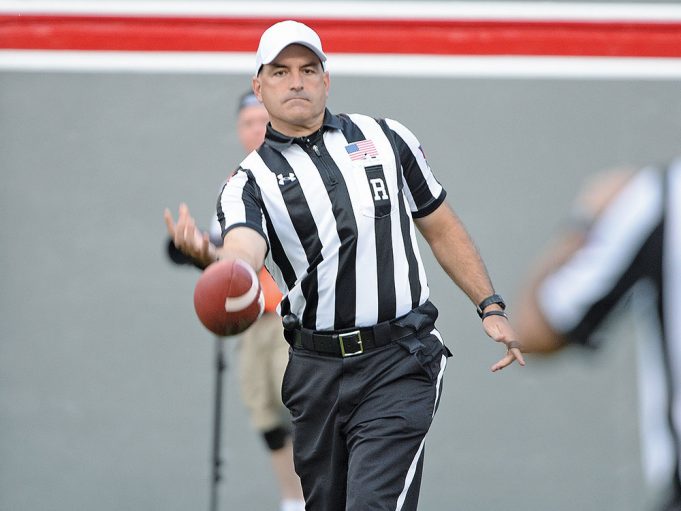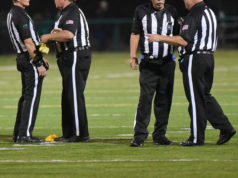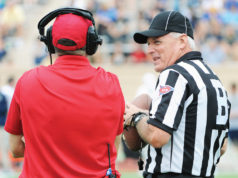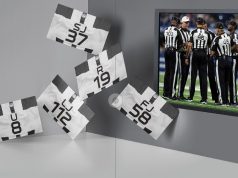It was the championship game for the local semi-pro league with a crew of six officials. A pass was intercepted and the down ended near the sideline. The side judge promptly called for a new ball, but the ball assistants were nowhere near to be found. After what seemed an eternity, they were located behind the team area playing catch. Even the most thorough plan may go awry when youngsters are involved.
The following is a ballhandling procedure that is guaranteed to make your crew look good if it’s properly executed.
Having competent ball assistants and briefing them properly before the game is essential. In an ideal situation there are at least four footballs available and four ball assistants, two on each sideline. It also makes it simpler if there is a league- or state association-mandated ball that is used by both teams. If each team has its own football, the procedures described below will have to be modified so that a particular team’s ball always goes out and comes in from its own sideline unless there is a ball assistant for each team on each sideline.
When requesting a ball from a ball assistant, the official should establish direct eye contact with the ball assistant and then ask for the ball verbally and non-verbally (i.e. clapping hands together or placing hands in front of the body as to catch the ball). The ball assistant should be instructed to toss the ball to the official with an underhand toss only after the official has requested the ball.
The ball should be changed whenever it becomes dead outside the top of the numbers (nine-yard marks) or after any change of possession. If the ball becomes dead in the field of play, the old ball is left in place until the new ball is properly positioned at the succeeding spot. The new ball is brought in by the deep official on that sideline (six-official crew) or by the back judge (five- or seven-official crew) and thrown directly to the umpire, who should be mobile enough to range between the tops of the numbers. Ball assistants should be instructed to stay off the field to decrease the chance they’ll run on the field at an inappropriate time.
Balls that become dead outside the field of play should be left there for the ball assistants to retrieve. Not only is it unnecessary for an official to chase after the ball, doing so prevents the official from dead-ball officiating.
In many areas it’s customary for a ball assistant to put a ball behind a goalpost when a try or field goal is being attempted. It can be easily accessed when the try ends while the ball assistant retrieves the one used on the try or field goal.
When the ball becomes dead between the tops of the numbers, the umpire (in most cases) will be able to directly retrieve the ball himself. On incomplete passes, a deep official must assist.
Inclement weather.
If the field is wet, the ball may have to be changed more often than described. Wet ball procedures should include a towel (black is preferred) for the umpire.
The ball assistants should also have towels. Encourage them to cover the ball with the towel rather than enclose it like a mummy. It takes longer to unwrap when it’s needed, plus the ball will absorb more water because it is exposed to more wet towel.
The umpire may wish to hold the ball and keep it covered between plays, then place it on the ground when the offense comes to the line.
The relay.
When the ball is relayed between officials, it should always be thrown underhanded so that it can be caught waist high. Most officials cannot accurately throw the ball more than 10-15 yards. It takes more time to run 10 yards and then throw the ball another 10 yards than it takes to throw the ball 20 yards; however, when you consider there is a high probability the 20-yard toss will go awry and have to be chased, it’s quicker to get close enough to ensure a smooth toss. It also looks much better.
When the play ends out of bounds or in a side zone, the official tossing the ball should ensure players returning to their side of the line will not get in the way.
If players are still in the way, the official should hesitate until they clear the area, or the official should move a couple of steps to find a clear path. Never try to “thread the needle” between players or try to throw over their heads. Both officials and players have on occasion been hit in the head by errant tosses. If the ball ends up on the turf, it could be accidentally kicked, wasting further time. In the process the crew risks looking like the Keystone Kops and worse yet, injury may result.
When a team employs a hurry-up offense, the umpire must range farther than normal to retrieve the ball. All other officials must be in position to observe the snap when the ball is spotted. That avoids creating the appearance the officials are holding up the game.
In summary, ballhandling has nothing to do with how accurately the game is called but will go a long way to enhance crew credibility and can appreciably reduce down time between plays.
What's Your Call? Leave a Comment:
Note: This article is archival in nature. Rules, interpretations, mechanics, philosophies and other information may or may not be correct for the current year.
This article is the copyright of ©Referee Enterprises, Inc., and may not be republished in whole or in part online, in print or in any capacity without expressed written permission from Referee. The article is made available for educational use by individuals.


















